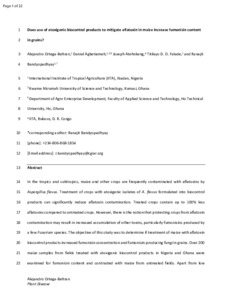| dc.contributor.author | Ortega-Beltran, A. |
| dc.contributor.author | Agbetiameh, D. |
| dc.contributor.author | Atehnkeng, J. |
| dc.contributor.author | Falade, T.D. |
| dc.contributor.author | Bandyopadhyay, R. |
| dc.date.accessioned | 2022-09-15T08:22:03Z |
| dc.date.available | 2022-09-15T08:22:03Z |
| dc.date.issued | 2021-09-07 |
| dc.identifier.citation | rtega-Beltran, A., Agbetiameh, D., Atehnkeng, J., Falade, T.D. & Bandyopadhyay, R. (2020). Does the use of atoxigenic biocontrol products to mitigate aflatoxin in maize increase fumonisin content in grains?. Plant Disease, 1-22. |
| dc.identifier.issn | 0191-2917 |
| dc.identifier.uri | https://hdl.handle.net/20.500.12478/7751 |
| dc.description.abstract | In the tropics and subtropics, maize and other crops are frequently contaminated with aflatoxins by Aspergillus flavus. Treatment of crops with atoxigenic isolates of A. flavus formulated into biocontrol products can significantly reduce aflatoxin contamination. Treated crops contain up to 100% less aflatoxins compared to untreated crops. However, there is the notion that protecting crops from aflatoxin contamination may result in increased accumulation of other toxins, particularly fumonisins produced by a few Fusarium species. The objective of this study was to determine if treatment of maize with aflatoxin biocontrol products increased fumonisin concentration and fumonisin-producing fungi in grains. Over 200 maize samples from fields treated with atoxigenic biocontrol products in Nigeria and Ghana were examined for fumonisin content and contrasted with maize from untreated fields. Apart from low aflatoxin levels, most treated maize also harbored fumonisin levels considered safe by the European Union (< 1 part per million). Most untreated maize also harbored equally low fumonisin levels but contained higher aflatoxin levels. In addition, during one year, we detected considerably less Fusarium spp. densities in treated maize than in untreated maize. Our results do not support the hypothesis that treating crops with atoxigenic isolates of A. flavus used in biocontrol formulations results in higher grain fumonisin levels. |
| dc.description.sponsorship | Bill & Melinda Gates Foundation |
| dc.format.extent | 1-22 |
| dc.language.iso | en |
| dc.subject | Aflatoxins |
| dc.subject | Biological Control |
| dc.subject | Aspergillus Flavus |
| dc.subject | Fumonisins |
| dc.subject | Fusarium |
| dc.subject | Maize |
| dc.title | Does use of atoxigenic biocontrol products to mitigate aflatoxin in maize increase fumonisin content in grains? |
| dc.type | Journal Article |
| cg.contributor.crp | Agriculture for Nutrition and Health |
| cg.contributor.crp | Maize |
| cg.contributor.affiliation | International Institute of Tropical Agriculture |
| cg.contributor.affiliation | Kwame Nkrumah University of Science and Technology |
| cg.contributor.affiliation | Ho Technical University |
| cg.coverage.region | Africa |
| cg.coverage.region | West Africa |
| cg.coverage.country | Ghana |
| cg.coverage.country | Nigeria |
| cg.coverage.hub | Headquarters and Western Africa Hub |
| cg.researchtheme | Plant Production and Health |
| cg.identifier.bibtexciteid | ORTEGABELTRAN:2020b |
| cg.isijournal | ISI Journal |
| cg.authorship.types | CGIAR and developing country institute |
| cg.iitasubject | Aflatoxin |
| cg.iitasubject | Agronomy |
| cg.iitasubject | Disease Control |
| cg.iitasubject | Maize |
| cg.iitasubject | Plant Breeding |
| cg.iitasubject | Plant Health |
| cg.iitasubject | Plant Production |
| cg.journal | Plant Disease |
| cg.notes | Published online: 7 Sept, 2021 |
| cg.accessibilitystatus | Open Access |
| cg.reviewstatus | Peer Review |
| cg.usagerightslicense | Creative Commons Attribution 4.0 (CC BY 0.0) |
| cg.targetaudience | Scientists |
| cg.identifier.doi | https://dx.doi.org/10.1094/pdis-07-20-1447-re |
| cg.iitaauthor.identifier | Alejandro Ortega-Beltran: 0000-0003-3747-8094 |
| cg.iitaauthor.identifier | Titilayo Falade: 0000-0001-5562-7861 |
| cg.iitaauthor.identifier | Ranajit Bandyopadhyay: 0000-0003-2422-4298 |
| cg.futureupdate.required | No |

